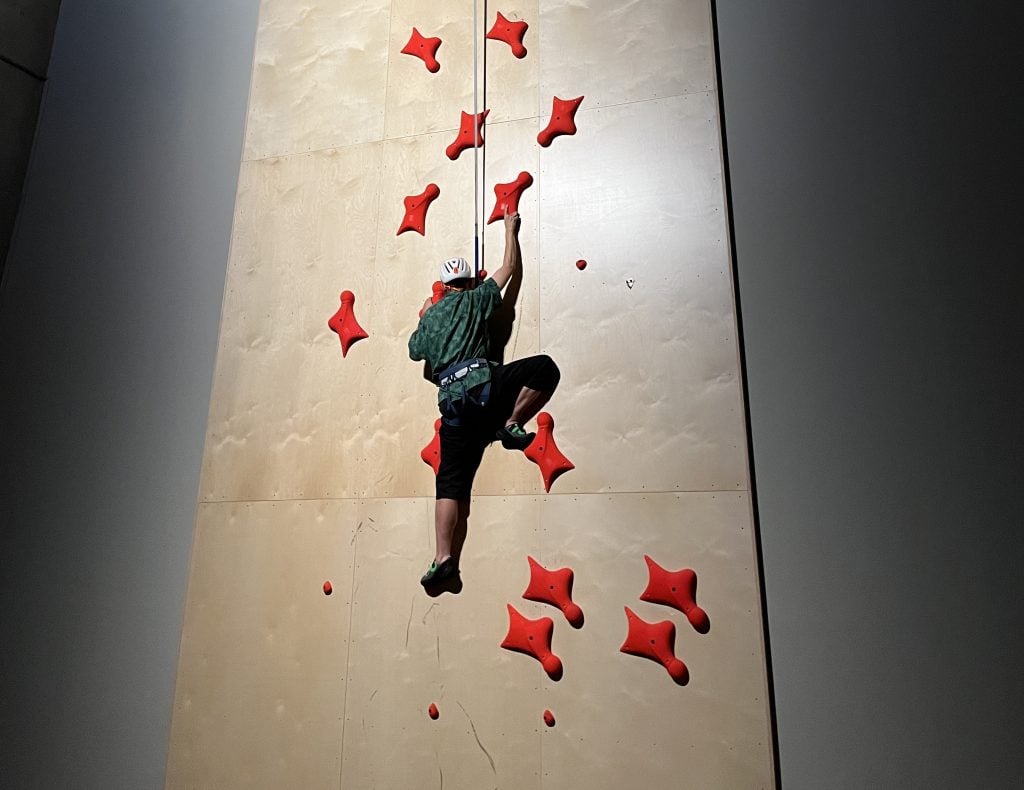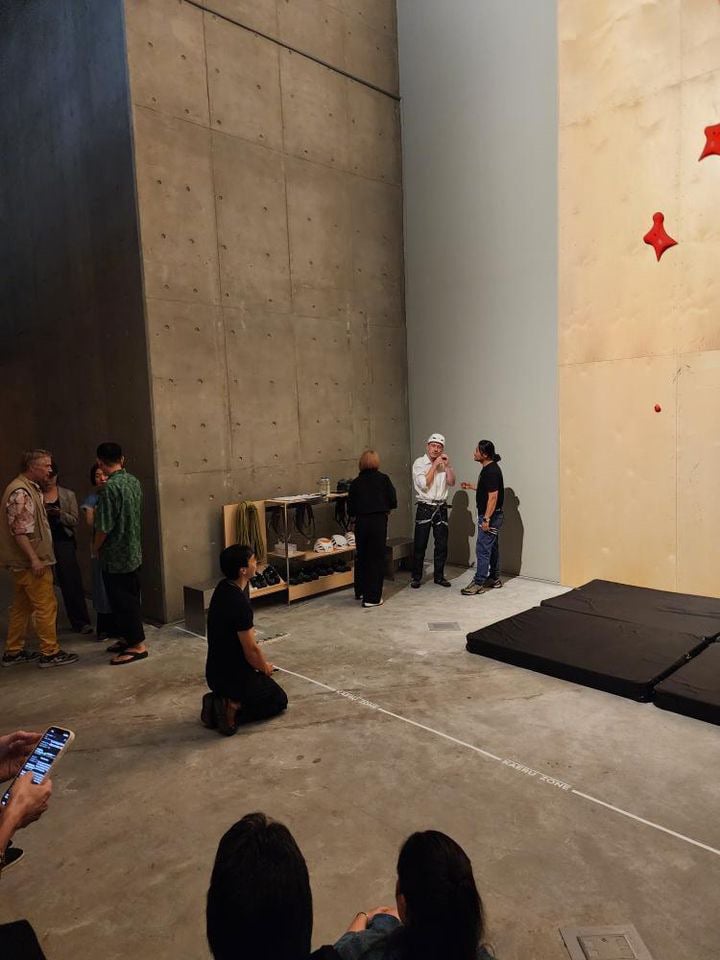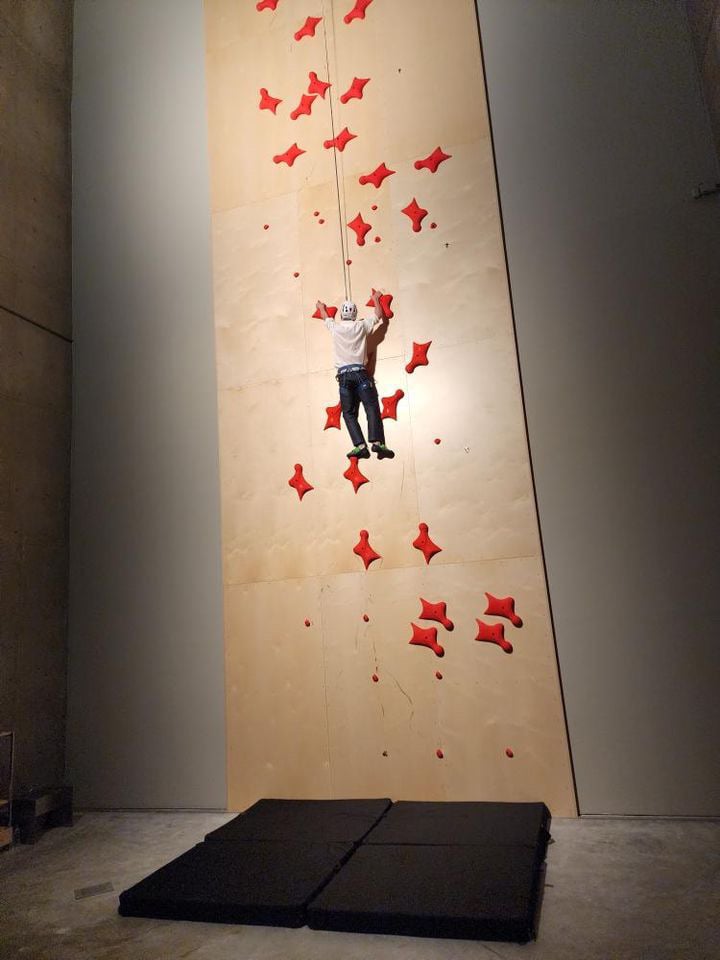Art & Exhibitions
Rock Climbing as Art? Seoul Show Dares Viewers to Ascend
Jihyun Jung is inviting viewers to put on a harness in an exhibition at the Leeum Museum curated by Rirkrit Tiravanija.

Jihyun Jung is inviting viewers to put on a harness in an exhibition at the Leeum Museum curated by Rirkrit Tiravanija.

Andrew Russeth

A week after experiencing the artist Jihyun Jung’s latest piece, I am still sore.
At the Leeum Museum of Art in Seoul, Jung has installed a nearly 50-foot-tall rock-climbing wall and titled it Kaeru (2024), “frog” in Japanese. Red climbing holds zig-zag up the installation in two parallel paths, and a safety rope hangs from an auto belay up above. From noon to 5 p.m., Friday through Sunday, visitors can strap on a helmet, harness, and climbing shoes and attempt to scale it.
During an opening reception last week, I gave it a try and found it to be… very difficult. Moving slowly, painfully slowly, I made it maybe 30 percent of the way up before slipping. Viewers down below nevertheless applauded, which helped my wounded pride. “At the opening, only one person from the general audience made it to the top,” Jung told me later, making me feel a little better.
Kaeru is part of a superb and surprising show called “Dream Screen” that artist Rirkrit Tiravanija has curated as part of the Leeum’s biannual “Art Spectrum” series, which is devoted to young artists.

Preparing to grapple with the artwork. Photo by Sun A Moon.
Jung was born in 1986 and started climbing a few years ago. “I’ve always been fascinated by artificial climbing walls inspired by nature,” he said. “This particular piece is motivated by speed climbing, the sport that started in nature but evolved into something quite different.” The height of his creation is set to the international standard, and the current record in the event is, astonishingly, just under five seconds.
The brave climbers who make it to the top of Jung’s creation are able to see, close up, two metal sculptures of frogs like those at the Okitama Shrine in Ise, Japan, where they are regarded as symbols of good fortune. The pair are “wishing for double the speed and double the luck,” Jung said.
Rock climbing in art is unusual, but it is not without its precedents. Matthew Barney was known to scale gallery walls (nude) with climbing equipment early in his career, and Andra Ursuta offered up some not-safe-for-work climbing walls at the New Museum in 2016, while Baseera Khan made climbing holds out of casts of her body parts for a 2017 display at Participant Inc. in New York.

Right before I fell. Photo by Sun A Moon
Jung has taken an almost-straightforward but slightly sly approach to the climbing-art genre, which is very much in keeping with his practice. His sculptures tend to look familiar at first, but they get stranger the longer you look at them. In a recent solo outing at the Art Sonje Center in Seoul, he presented a disassembled billboard and objects that he 3D-printed from iPhone scans of automobile scraps. Here at Leeum, he’s using store-bought climbing equipment, but he’s doubled everything and added those frogs. A certain eerie, uncanny feeling lingers.
It’s an artwork about tough journeys and split-second decisions, and it’s an artwork that offers challenges: Are you willing to climb in front of an audience? Can you make it to the top? The vast majority of people will not be able to, and so it also poses fun, fruitful questions about how to make sense of—and how to evaluate—an artwork that you cannot fully experience.
But even for those who decide not to put on a harness and make an attempt at the summit, there is a lot of pleasure to be had. “Climbing is both a sport and an art form, combining sculptural beauty and performative elements,” Jung told me. “It’s fascinating to watch people solve the route in their own way as they climb. I love the atmosphere—the cheers and applause from the audience, the dynamic poses of people falling, and the sense of accomplishment when someone finally reaches the top.”